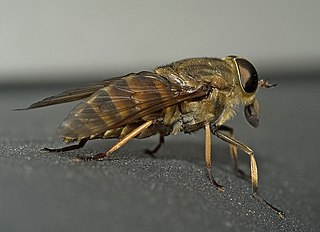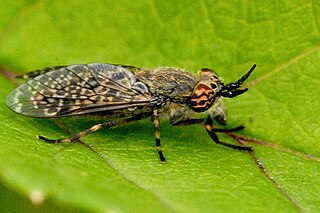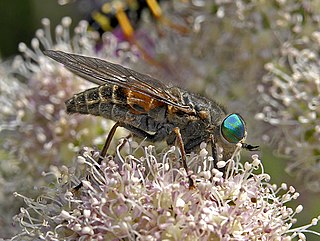
Horse-flies and deer flies are true flies in the family Tabanidae in the insect order Diptera. The adults are often large and agile in flight. Only female horseflies bite land vertebrates, including humans, to obtain blood. They prefer to fly in sunlight, avoiding dark and shady areas, and are inactive at night. They are found all over the world except for some islands and the polar regions. Both horse-flies and botflies (Oestridae) are sometimes referred to as gadflies.

Tabanus bovinus, sometimes called the pale giant horse-fly, is a species of biting horse-fly. As the scientific name suggests, it prefers bovine animals as the source of blood, although it may bite other kind of mammals as well. The insect is relatively large for a horse-fly, adults usually being 25–30 mm long. Like most other horseflies, its compound eyes are very colorful with stripe-like patterns. Its body and wings are mostly colored brownish gray. It is quite fast and an able flier, being capable of evading most attempts to swat it with ease. It bites humans infrequently, because of its preference of bovine animals. This loud-buzzing horse-fly can be a nuisance, as it circles around its target and occasionally lands to deliver a bite. However, to humans it is considerably less harmful than deer flies (Chrysops), which bite much more vigorously.

Tabanus is a genus of biting horseflies of the family Tabanidae. Females have scissor-like mouthparts that are able to penetrate the skin of livestock animals. The horsefly can then extract and ingest the animal's blood. Horseflies of this genus are known to be potential vectors of anthrax, worms and trypanosomes. Some species, such as Tabanus bovinus, prefer bovine animals and are less harmful to humans. The genus contains hundreds of species and many species groups.

Tabanus nigrovittatus, also known as the greenhead horse fly, salt marsh greenhead, or simply the greenhead fly, greenhead or greenfly, is a species of horse-fly commonly found around the coastal marshes and wetlands of the Eastern United States. They are smaller than most horsefly species, instead being close in size to a common housefly. The biting females are a considerable pest to both humans and animals while they seek a source of blood protein to produce additional eggs: greenhead larvae develop in the mud of salt marshes, and adult flies mate and lay their first group of eggs in the marsh, but to lay more eggs a female fly needs to drink an animal's blood, and so female greenheads which have laid eggs fly inland to look for prey in the area bordering the marsh; they can stay on land looking for animals to bite for up to four weeks. Their bites itch, like those of mosquitoes, but are more painful, since greenheads feed by cutting a wound in the skin with scissor-like mouth parts and sucking the blood released through it. Females live for three to four weeks and may lay about 100 to 200 eggs per blood meal. The eggs are laid on the grass in a salt marsh; the larvae live in the intertidal mud of the salt marsh for one or two years, preying on other invertebrates, before pupating in early spring. The adult flies emerge in late spring and are most common from late June to August.

Tabanus bromius, sometimes called the band-eyed brown horsefly, is a species of biting horseflies.

Tabanus autumnalis, the large marsh horsefly, is a medium-sized species of biting horse-fly. It is somewhat scarce compared to T. bromius and T. bovinus. This species shows slightly more of a preference for coastal marsh than some of the other European Tabanus, sometime even found in saltmashes. Wing length is 13–16 mm and about 16–22 mm in body length.

Tabanus cordiger also known as the plain-eyed grey horsefly is a species of biting horse-fly.

Tabanus glaucopis, also known as the downland horsefly, is a species of biting horse-fly.
Tabanus miki also known as the plain-eyed brown horsefly is a species of biting horse-fly.

Tabanus sudeticus, also known as the dark giant horsefly, is a species of biting horse-fly. It is the heaviest fly in Europe.
Tabanus spodopterus also known as the black horned giant horsefly is a species of biting horse-fly. It is widespread in Europe, but only one doubtful specimen has been found in the United Kingdom.

Tabanus eggeri is a Mediterranean species of biting horse-fly, found in southern France, Italy, Albania, Croatia, Herzegovina, Bulgaria, Portugal and Morocco. There are also unverified accounts of sightings in Spain, Austria and Israel.
Tabanus darimonti is a Mediterranean species of biting horse-fly. Only female specimens are known.

Haematopota pluvialis, the common horse fly or notch-horned cleg fly, or simply cleg in Scotland and northern parts of Ireland, is a species belonging to the family Tabanidae subfamily Tabaninae.

Philipomyia aprica is a species of horse fly of the family Tabanidae, subfamily Tabaninae.

Chrysops caecutiens, common name splayed deer fly, is a species of horse fly belonging to the family Tabanidae. It is also known by the colloquial name Scotch Cleg.

Haematopota crassicornis, the black-horned cleg is a species in the horse-fly family, Tabanidae.
Haematopota bigoti is a species of Horse-fly.

Tabanus quatuornotatus is a species of biting horse-fly.

Hybomitra montana, the slender-horned horsefly, is a species of horse flies in the family Tabanidae.

















